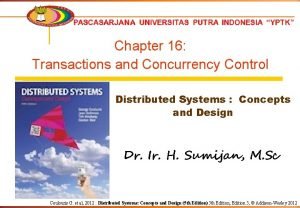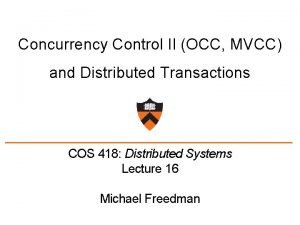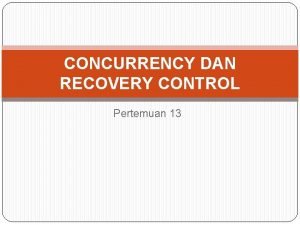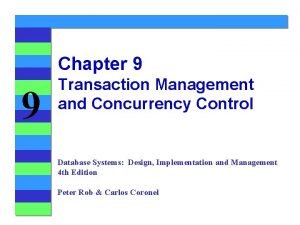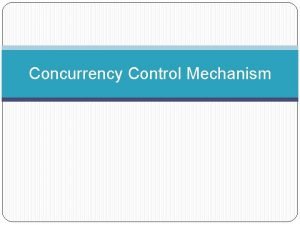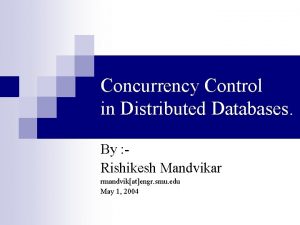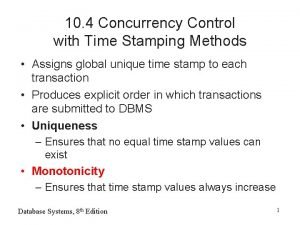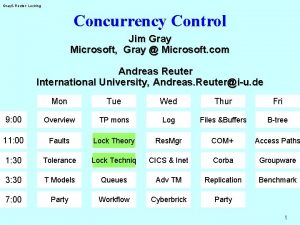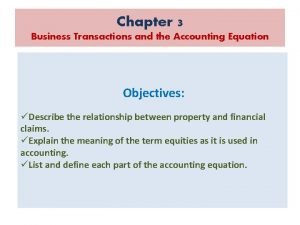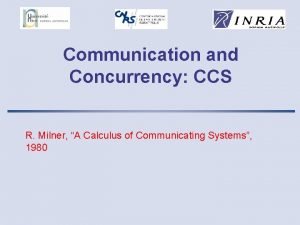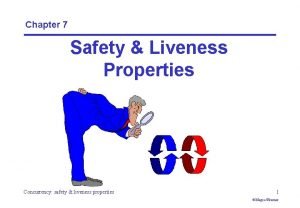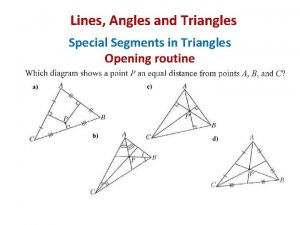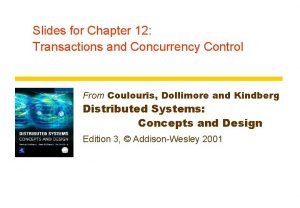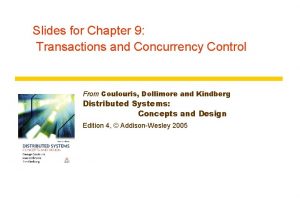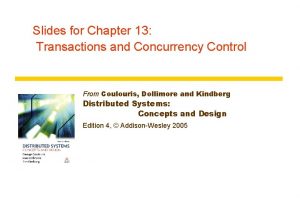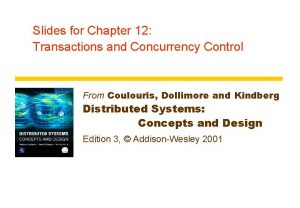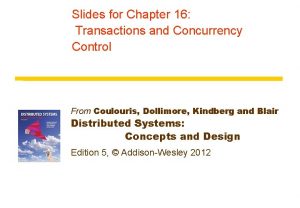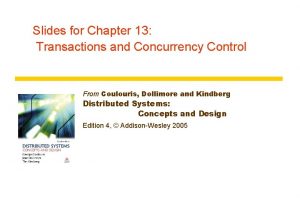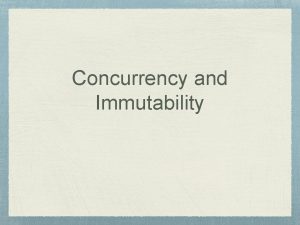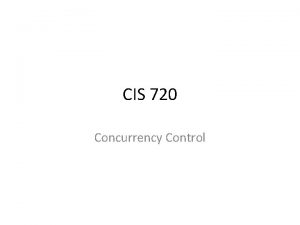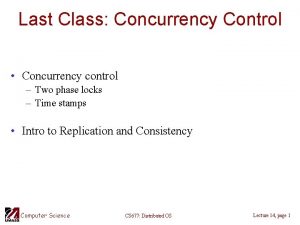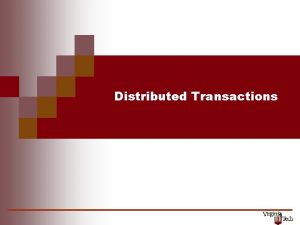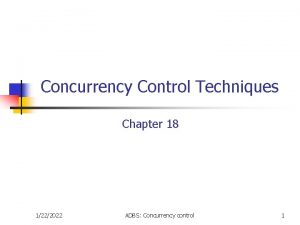Slides for Chapter 16 Transactions and Concurrency Control









































- Slides: 41

Slides for Chapter 16: Transactions and Concurrency Control From Coulouris, Dollimore, Kindberg and Blair Distributed Systems: Concepts and Design Edition 5, © Addison-Wesley 2012

Figure 16. 1 Operations of the Account interface deposit(amount) deposit amount in the account withdraw(amount) withdraw amount from the account get. Balance() -> amount return the balance of the account set. Balance(amount) set the balance of the account to amount Operations of the Branch interface create(name) -> account create a new account with a given name look. Up(name) -> account return a reference to the account with the given name branch. Total() -> amount return the total of all the balances at the branch Instructor’s Guide for Coulouris, Dollimore, Kindberg and Blair, Distributed Systems: Concepts and Design Edn. 5 © Pearson Education 2012

Figure 16. 2 A client’s banking transaction T: a. withdraw(100); b. deposit(100); c. withdraw(200); b. deposit(200); Instructor’s Guide for Coulouris, Dollimore, Kindberg and Blair, Distributed Systems: Concepts and Design Edn. 5 © Pearson Education 2012

Figure 16. 3 Operations in Coordinator interface open. Transaction() -> trans; starts a new transaction and delivers a unique TID trans. This identifier will be used in the other operations in the transaction. close. Transaction(trans) -> (commit, abort); ends a transaction: a commit return value indicates that the transaction has committed; an abort return value indicates that it has aborted. abort. Transaction(trans); aborts the transaction. Instructor’s Guide for Coulouris, Dollimore, Kindberg and Blair, Distributed Systems: Concepts and Design Edn. 5 © Pearson Education 2012

Figure 16. 4 Transaction life histories Successful Aborted by client Aborted by server open. Transaction operation operation server aborts transaction operation close. Transaction abort. Transaction operation ERROR reported to client Instructor’s Guide for Coulouris, Dollimore, Kindberg and Blair, Distributed Systems: Concepts and Design Edn. 5 © Pearson Education 2012

ACID Guarantees Atomicity All or nothing Consistency From one consistent state to the other Isolation no interference Durability 6

Figure 16. 5 The lost update problem Transaction T : Transaction U: balance = b. get. Balance(); b. set. Balance(balance*1. 1); a. withdraw(balance/10) balance = b. get. Balance(); b. set. Balance(balance*1. 1); c. withdraw(balance/10) balance = b. get. Balance(); b. set. Balance(balance*1. 1); a. withdraw(balance/10) $200 balance = b. get. Balance(); $200 b. set. Balance(balance*1. 1); $220 c. withdraw(balance/10) $280 $220 $80 Instructor’s Guide for Coulouris, Dollimore, Kindberg and Blair, Distributed Systems: Concepts and Design Edn. 5 © Pearson Education 2012

Figure 16. 6 The inconsistent retrievals problem Transaction V: a. withdraw(100) b. deposit(100) a. withdraw(100); Transaction W: a. Branch. branch. Total() $100 total = a. get. Balance() $100 total = total+b. get. Balance() $300 total = total+c. get. Balance() b. deposit(100) $300 Instructor’s Guide for Coulouris, Dollimore, Kindberg and Blair, Distributed Systems: Concepts and Design Edn. 5 © Pearson Education 2012

Why previous issues occur? Previous schedules are not serializable i. e. , have the same effect as a serial execution Interleaved schedules must have the same effect on variables as serial schedules Need to access objects (for read/write) in a similar manner to a serial execution 9

Figure 16. 7 A serially equivalent interleaving of T and U Transaction T: Transaction U: balance = b. get. Balance() b. set. Balance(balance*1. 1) a. withdraw(balance/10) balance = b. get. Balance() b. set. Balance(balance*1. 1) c. withdraw(balance/10) balance = b. get. Balance() $200 b. set. Balance(balance*1. 1) $220 a. withdraw(balance/10) balance = b. get. Balance() $220 b. set. Balance(balance*1. 1) $242 c. withdraw(balance/10) $278 $80 Instructor’s Guide for Coulouris, Dollimore, Kindberg and Blair, Distributed Systems: Concepts and Design Edn. 5 © Pearson Education 2012

Figure 16. 8 A serially equivalent interleaving of V and W Transaction V: Transaction W: a. withdraw(100); b. deposit(100) a. Branch. branch. Total() a. withdraw(100); $100 b. deposit(100) $300 total = a. get. Balance() $100 total = total+b. get. Balance() $400 total = total+c. get. Balance(). . . Instructor’s Guide for Coulouris, Dollimore, Kindberg and Blair, Distributed Systems: Concepts and Design Edn. 5 © Pearson Education 2012

Figure 16. 9 Read and write operation conflict rules Operations of different Conflict transactions read No read write Yes Reason Because the effect of a pair of read operations does not depend on the order in which they are executed Because the effect of a read and a write operation depends on the order of their execution Because the effect of a pair of write operations depends on the order of their execution Instructor’s Guide for Coulouris, Dollimore, Kindberg and Blair, Distributed Systems: Concepts and Design Edn. 5 © Pearson Education 2012

Figure 16. 10 A non-serially equivalent interleaving of operations of transactions T and U Transaction T: x = read(i) write(i, 10) write(j, 20) Transaction U: y = read(j) write(j, 30) z = read (i) Instructor’s Guide for Coulouris, Dollimore, Kindberg and Blair, Distributed Systems: Concepts and Design Edn. 5 © Pearson Education 2012

Figure 16. 11 A dirty read when transaction T aborts Transaction T: Transaction U: a. get. Balance() a. set. Balance(balance + 10) a. get. Balance() a. set. Balance(balance + 20) balance = a. get. Balance() $100 a. set. Balance(balance + 10) $110 balance = a. get. Balance() $110 a. set. Balance(balance + 20) $130 commit transaction abort transaction Instructor’s Guide for Coulouris, Dollimore, Kindberg and Blair, Distributed Systems: Concepts and Design Edn. 5 © Pearson Education 2012

Figure 16. 12 Overwriting uncommitted values Transaction T: Transaction U: a. set. Balance(105) a. set. Balance(110) a. set. Balance(105) $100 $105 a. set. Balance(110) Instructor’s Guide for Coulouris, Dollimore, Kindberg and Blair, Distributed Systems: Concepts and Design Edn. 5 © Pearson Education 2012 $110

Figure 16. 13 Nested transactions T : top-level transaction T 1 = open. Sub. Transaction T 2 = open. Sub. Transaction T 1 : commit T 2 : open. Sub. Transaction T 11 : T 12 : prov. commit open. Sub. Transaction T 21 : abort open. Sub. Transaction prov. commit T 211 : prov. commit Instructor’s Guide for Coulouris, Dollimore, Kindberg and Blair, Distributed Systems: Concepts and Design Edn. 5 © Pearson Education 2012

Figure 16. 14 Transactions T and U with exclusive locks Transaction T: balance = b. get. Balance() b. set. Balance(bal*1. 1) a. withdraw(bal/10) Transaction U: Operations Locks Operations open. Transaction bal = b. get. Balance() lock B balance = b. get. Balance() b. set. Balance(bal*1. 1) c. withdraw(bal/10) Locks open. Transaction b. set. Balance(bal*1. 1) a. withdraw(bal/10) lock A close. Transaction unlock A, B bal = b. get. Balance() waits for T’s lock on B lock B b. set. Balance(bal*1. 1) c. withdraw(bal/10) lock C close. Transaction unlock B, C Instructor’s Guide for Coulouris, Dollimore, Kindberg and Blair, Distributed Systems: Concepts and Design Edn. 5 © Pearson Education 2012

Figure 16. 15 Lock compatibility For one object Lock already set Lock requested read write none OK OK read OK wait write wait Instructor’s Guide for Coulouris, Dollimore, Kindberg and Blair, Distributed Systems: Concepts and Design Edn. 5 © Pearson Education 2012

Figure 16. 16 Use of locks in strict two-phase locking 1. When an operation accesses an object within a transaction: (a) If the object is not already locked, it is locked and the operation proceeds. (b) If the object has a conflicting lock set by another transaction, the transaction must wait until it is unlocked. (c) If the object has a non-conflicting lock set by another transaction, the lock is shared and the operation proceeds. (d) If the object has already been locked in the same transaction, the lock will be promoted if necessary and the operation proceeds. (Where promotion is prevented by a conflicting lock, rule (b) is used. ) 2. When a transaction is committed or aborted, the server unlocks all objects it locked for the transaction. Instructor’s Guide for Coulouris, Dollimore, Kindberg and Blair, Distributed Systems: Concepts and Design Edn. 5 © Pearson Education 2012

Figure 16. 17 Lock class public class Lock { private Object object; // the object being protected by the lock private Vector holders; // the TIDs of current holders private Lock. Type lock. Type; // the current type public synchronized void acquire(Trans. ID trans, Lock. Type a. Lock. Type ){ while(/*another transaction holds the lock in conflicing mode*/) { try { wait(); }catch ( Interrupted. Exception e){/*. . . */ } } if(holders. is. Empty()) { // no TIDs hold lock holders. add. Element(trans); lock. Type = a. Lock. Type; } else if(/*another transaction holds the lock, share it*/ ) ){ if(/* this transaction not a holder*/) holders. add. Element(trans); } else if (/* this transaction is a holder but needs a more exclusive lock*/) lock. Type. promote(); } } Continues on next slide Instructor’s Guide for Coulouris, Dollimore, Kindberg and Blair, Distributed Systems: Concepts and Design Edn. 5 © Pearson Education 2012

Figure 16. 17 continued public synchronized void release(Trans. ID trans ){ holders. remove. Element(trans); // set locktype to none notify. All(); } } // remove this holder Instructor’s Guide for Coulouris, Dollimore, Kindberg and Blair, Distributed Systems: Concepts and Design Edn. 5 © Pearson Education 2012

Figure 16. 18 Lock. Manager class public class Lock. Manager { private Hashtable the. Locks; public void set. Lock(Object object, Trans. ID trans, Lock. Type lock. Type){ Lock found. Lock; synchronized(this){ // find the lock associated with object // if there isn’t one, create it and add to the hashtable } found. Lock. acquire(trans, lock. Type); } } // synchronize this one because we want to remove all entries public synchronized void un. Lock(Trans. ID trans) { Enumeration e = the. Locks. elements(); while(e. has. More. Elements()){ Lock a. Lock = (Lock)(e. next. Element()); if(/* trans is a holder of this lock*/ ) a. Lock. release(trans); } } Instructor’s Guide for Coulouris, Dollimore, Kindberg and Blair, Distributed Systems: Concepts and Design Edn. 5 © Pearson Education 2012

Figure 16. 19 Deadlock with write locks Transaction T Operations Locks a. deposit(100); write lock A Transaction U Operations Locks b. deposit(200) write lock B a. withdraw(200); waits for T’s lock on A b. withdraw(100) waits for U’s lock on B Instructor’s Guide for Coulouris, Dollimore, Kindberg and Blair, Distributed Systems: Concepts and Design Edn. 5 © Pearson Education 2012

Figure 16. 20 The wait-for graph for Figure 16. 19 Held by Waits for A T U U T Waits for B Instructor’s Guide for Coulouris, Dollimore, Kindberg and Blair, Distributed Systems: Concepts and Design Edn. 5 © Pearson Education 2012 Held by

Figure 16. 21 A cycle in a wait-for graph U T V Instructor’s Guide for Coulouris, Dollimore, Kindberg and Blair, Distributed Systems: Concepts and Design Edn. 5 © Pearson Education 2012

Figure 16. 22 Another wait-for graph V T Held by T C W Held by U B Held by W V U Instructor’s Guide for Coulouris, Dollimore, Kindberg and Blair, Distributed Systems: Concepts and Design Edn. 5 © Pearson Education 2012 Waits for

Figure 16. 23 Resolution of the deadlock in Figure 15. 19 Transaction T Operations Locks a. deposit(100); write lock A Transaction U Operations Locks b. deposit(200) write lock B a. withdraw(200); waits for T’s lock on A a. withdraw(200); write locks A unlock A, B b. withdraw(100) waits for U’s lock on B (timeout elapses) T’s lock on A becomes vulnerable, unlock A, abort T Instructor’s Guide for Coulouris, Dollimore, Kindberg and Blair, Distributed Systems: Concepts and Design Edn. 5 © Pearson Education 2012

Figure 16. 24 Lock compatibility (read, write and commit locks) For one object Lock already set Lock to be set read write commit none OK OK OK read OK OK wait write OK wait commit wait Instructor’s Guide for Coulouris, Dollimore, Kindberg and Blair, Distributed Systems: Concepts and Design Edn. 5 © Pearson Education 2012

Figure 16. 25 Lock hierarchy for the banking example Branch A B C Account Instructor’s Guide for Coulouris, Dollimore, Kindberg and Blair, Distributed Systems: Concepts and Design Edn. 5 © Pearson Education 2012

Figure 16. 26 Lock hierarchy for a diary Week Monday Tuesday Wednesday Thursday Friday time slots 9: 00– 10: 00– 11: 00– 12: 00– 13: 00– 14: 00– 15: 00– 16: 00 Instructor’s Guide for Coulouris, Dollimore, Kindberg and Blair, Distributed Systems: Concepts and Design Edn. 5 © Pearson Education 2012

Figure 16. 27 Lock compatibility table for hierarchic locks read Lock to be set write I-read I-write none OK OK read OK wait write wait I-read OK wait OK OK I-write wait OK OK For one object Lock already set Instructor’s Guide for Coulouris, Dollimore, Kindberg and Blair, Distributed Systems: Concepts and Design Edn. 5 © Pearson Education 2012

Table on page 708 Serializability of transaction T with respect to transaction Ti Tv Ti Rule write read 1. Ti must not read objects written by Tv read write 2. Tv must not read objects written by Ti write 3. Ti must not write objects written by Tv and Tv must not write objects written by Ti Instructor’s Guide for Coulouris, Dollimore, Kindberg and Blair, Distributed Systems: Concepts and Design Edn. 5 © Pearson Education 2012

Figure 16. 28 Validation of transactions Working Validation Update T 1 Earlier committed transactions T 2 T 3 Transaction being validated active Later active transactions Tv 1 active 2 Instructor’s Guide for Coulouris, Dollimore, Kindberg and Blair, Distributed Systems: Concepts and Design Edn. 5 © Pearson Education 2012

Page 709 -710 Validation of Transactions Backward validation of transaction Tv boolean valid = true; for (int Ti = start. Tn+1; Ti <= finish. Tn; Ti++){ if (read set of Tv intersects write set of Ti) valid = false; } Forward validation of transaction Tv boolean valid = true; for (int Tid = active 1; Tid <= active. N; Tid++){ if (write set of Tv intersects read set of Tid) valid = false; } Instructor’s Guide for Coulouris, Dollimore, Kindberg and Blair, Distributed Systems: Concepts and Design Edn. 5 © Pearson Education 2012

Figure 16. 29 Operation conflicts for timestamp ordering Rule Tc 1. write Ti read 2. write Tc must not write an object that has been written by any Ti where Ti >Tc this requires that Tc > write timestamp of the committed object. 3. read write Tc must not read an object that has been written by any Ti where. Ti >Tc this requires that Tc > write timestamp of the committed object. Tc must not write an object that has been read by any Ti where Ti >Tc this requires that Tc ≥ the maximum read timestamp of the object. Instructor’s Guide for Coulouris, Dollimore, Kindberg and Blair, Distributed Systems: Concepts and Design Edn. 5 © Pearson Education 2012

Figure 16. 30 Write operations and timestamps (a) (b) T 3 write Before T 2 After T 2 Before T 3 After T 1 Key: T 2 Committed T 3 Time (c) T 3 write (d) T 3 write Before T 1 T 4 After T 1 T 3 T 4 Time Before T 4 After T 4 Ti Transaction aborts Time Instructor’s Guide for Coulouris, Dollimore, Kindberg and Blair, Distributed Systems: Concepts and Design Edn. 5 © Pearson Education 2012 Ti Tentative object produced by transaction Ti (with write timestamp Ti) T 1<T 2<T 3<T 4

Page 713 Timestamp ordering write rule if (Tc ≥ maximum read timestamp on D && Tc > write timestamp on committed version of D) perform write operation on tentative version of D with write timestamp Tc else /* write is too late */ Abort transaction Tc Instructor’s Guide for Coulouris, Dollimore, Kindberg and Blair, Distributed Systems: Concepts and Design Edn. 5 © Pearson Education 2012

Page 714 Timestamp ordering read rule if ( Tc > write timestamp on committed version of D) { let Dselected be the version of D with the maximum write timestamp ≤ Tc if (Dselected is committed) perform read operation on the version Dselected else Wait until the transaction that made version Dselected commits or aborts then reapply the read rule } else Abort transaction Tc Instructor’s Guide for Coulouris, Dollimore, Kindberg and Blair, Distributed Systems: Concepts and Design Edn. 5 © Pearson Education 2012

Figure 16. 31 Read operations and timestamps (b) T 3 read (a) T 3 read Key: read proceeds T 2 Selected Time T 2 Selected read proceeds Selected Ti Time Committed Ti (d) T 3 read (c) T 3 read T 1 T 4 Tentative read waits T 4 Time Transaction aborts object produced by transaction Ti (with write timestamp Ti) T 1 < T 2 < T 3 < T 4 Time Instructor’s Guide for Coulouris, Dollimore, Kindberg and Blair, Distributed Systems: Concepts and Design Edn. 5 © Pearson Education 2012

Figure 16. 32 Timestamps in transactions T and U Timestamps and versions of objects T U A RTS WTS {} S open. Transaction bal = b. get. Balance() b. set. Balance(bal*1. 1) B C RTS WTS {} S {T} open. Transaction S, T bal = b. get. Balance() wait for T S, T a. withdraw(bal/10) commit T bal = b. get. Balance() b. set. Balance(bal*1. 1) c. withdraw(bal/10) T {U} T, U Instructor’s Guide for Coulouris, Dollimore, Kindberg and Blair, Distributed Systems: Concepts and Design Edn. 5 © Pearson Education 2012 S, U

Figure 16. 33 Late write operation would invalidate a read T 3 read; T 1 T 3 write; T 2 T 5 read; T 4 write; T 3 T 5 T 3 Time T 1 < T 2 < T 3 < T 4 < T 5 Key: Ti Tk Committed Tentative object produced by transaction Ti (with write timestamp Ti and read timestamp Tk) Instructor’s Guide for Coulouris, Dollimore, Kindberg and Blair, Distributed Systems: Concepts and Design Edn. 5 © Pearson Education 2012
 Transactions and concurrency control in distributed systems
Transactions and concurrency control in distributed systems Example of concurrency control in dbms
Example of concurrency control in dbms Concurrency control in distributed transactions
Concurrency control in distributed transactions Pessimistic concurrency control
Pessimistic concurrency control Pengertian concurrency
Pengertian concurrency Transaction management in dbms examples
Transaction management in dbms examples Transaction management and concurrency control
Transaction management and concurrency control Pitfalls of lock based protocol
Pitfalls of lock based protocol Concurrency control in distributed databases
Concurrency control in distributed databases Time stamping in database
Time stamping in database Jim gray microsoft
Jim gray microsoft Timestamp based concurrency control
Timestamp based concurrency control On optimistic methods for concurrency control
On optimistic methods for concurrency control A small child slides down the four frictionless slides
A small child slides down the four frictionless slides Energy of four forces quick check
Energy of four forces quick check Analyzing transactions in accounting
Analyzing transactions in accounting Part two analyzing transactions in a cash control system
Part two analyzing transactions in a cash control system Problem 3-4 classifying accounts answers
Problem 3-4 classifying accounts answers Ccs milner
Ccs milner Safety and liveness in concurrency
Safety and liveness in concurrency Special segments of triangles
Special segments of triangles Fspos
Fspos Typiska novell drag
Typiska novell drag Nationell inriktning för artificiell intelligens
Nationell inriktning för artificiell intelligens Ekologiskt fotavtryck
Ekologiskt fotavtryck Varför kallas perioden 1918-1939 för mellankrigstiden?
Varför kallas perioden 1918-1939 för mellankrigstiden? En lathund för arbete med kontinuitetshantering
En lathund för arbete med kontinuitetshantering Kassaregister ideell förening
Kassaregister ideell förening Personlig tidbok för yrkesförare
Personlig tidbok för yrkesförare Sura för anatom
Sura för anatom Förklara densitet för barn
Förklara densitet för barn Datorkunskap för nybörjare
Datorkunskap för nybörjare Boverket ka
Boverket ka Debatt artikel mall
Debatt artikel mall För och nackdelar med firo
För och nackdelar med firo Nyckelkompetenser för livslångt lärande
Nyckelkompetenser för livslångt lärande Påbyggnader för flakfordon
Påbyggnader för flakfordon Vätsketryck formel
Vätsketryck formel Offentlig förvaltning
Offentlig förvaltning Bo bergman jag fryser om dina händer
Bo bergman jag fryser om dina händer Presentera för publik crossboss
Presentera för publik crossboss Argument för teckenspråk som minoritetsspråk
Argument för teckenspråk som minoritetsspråk
